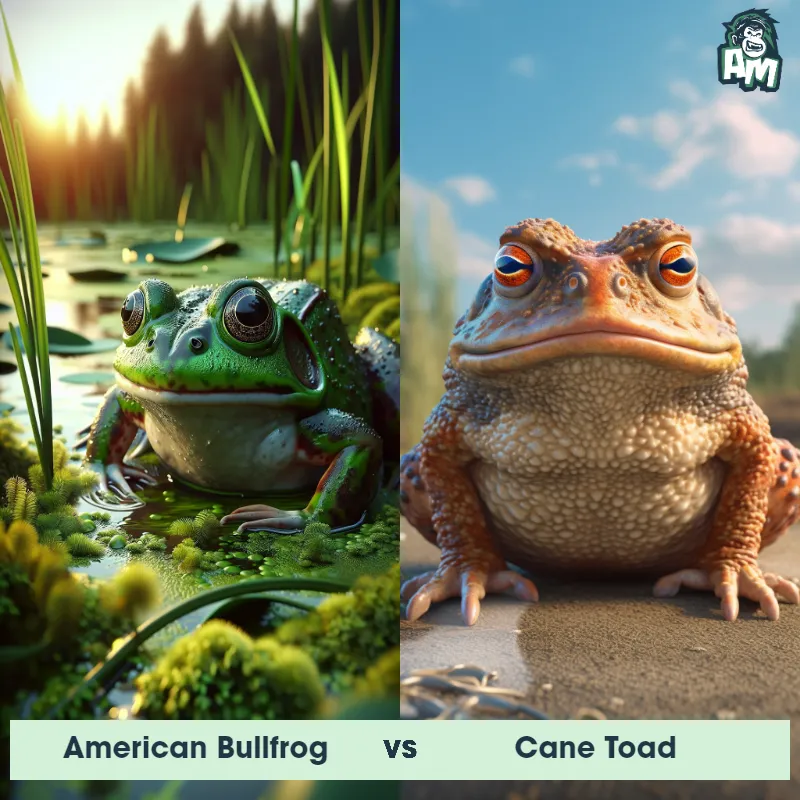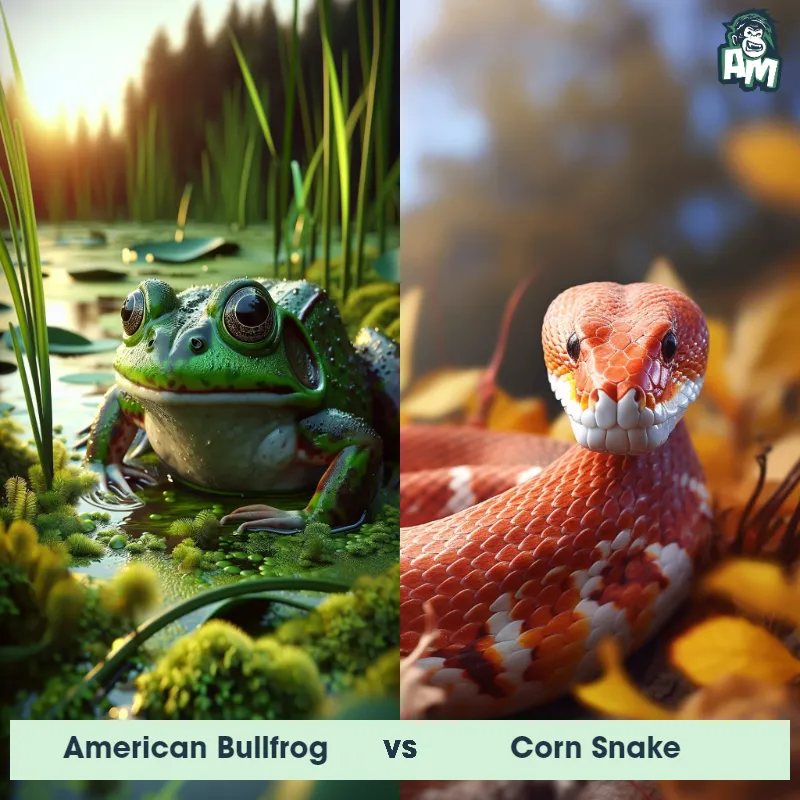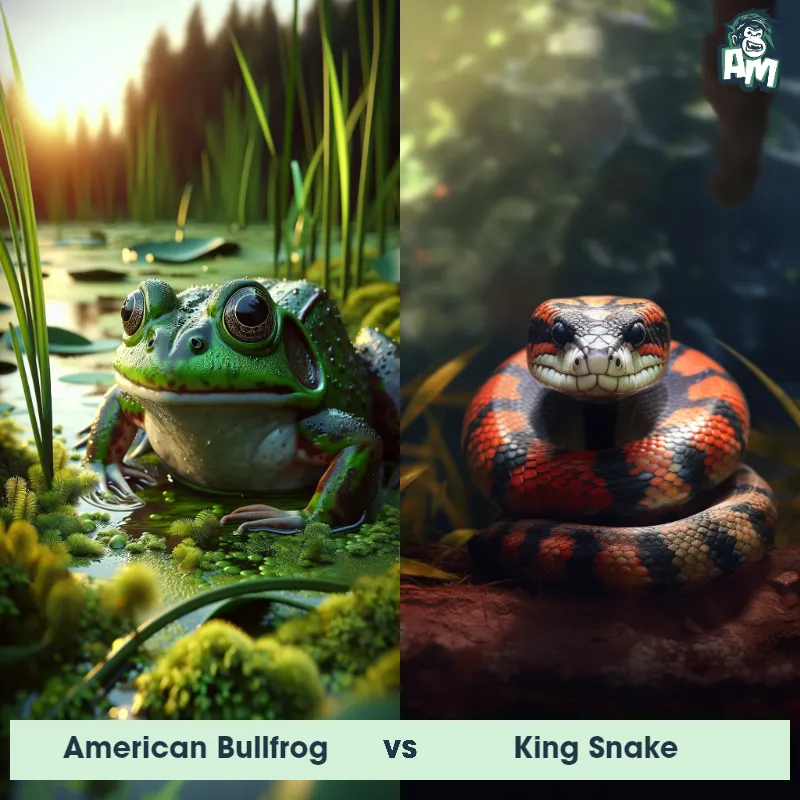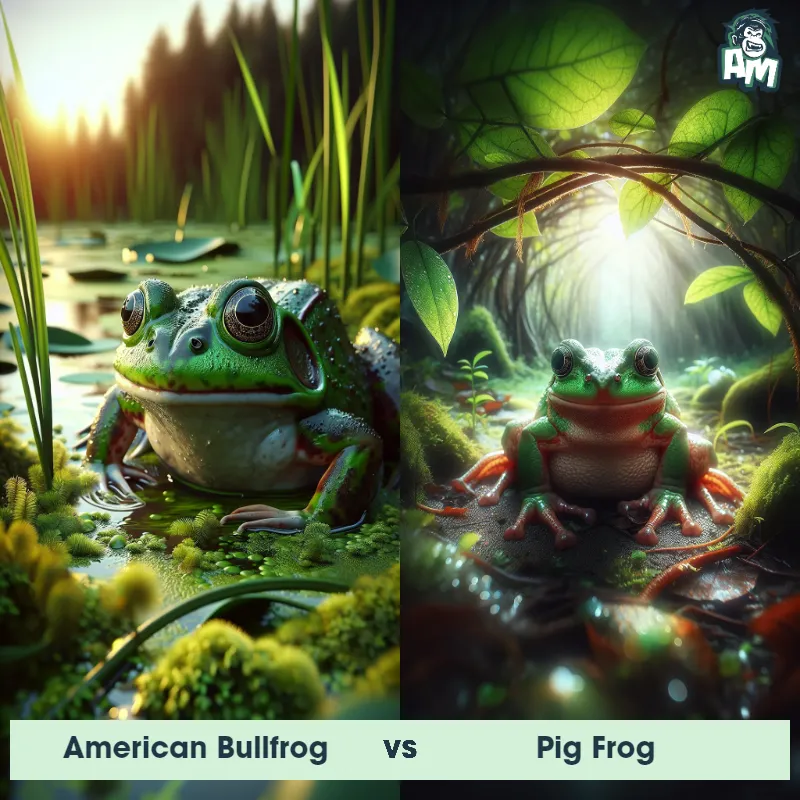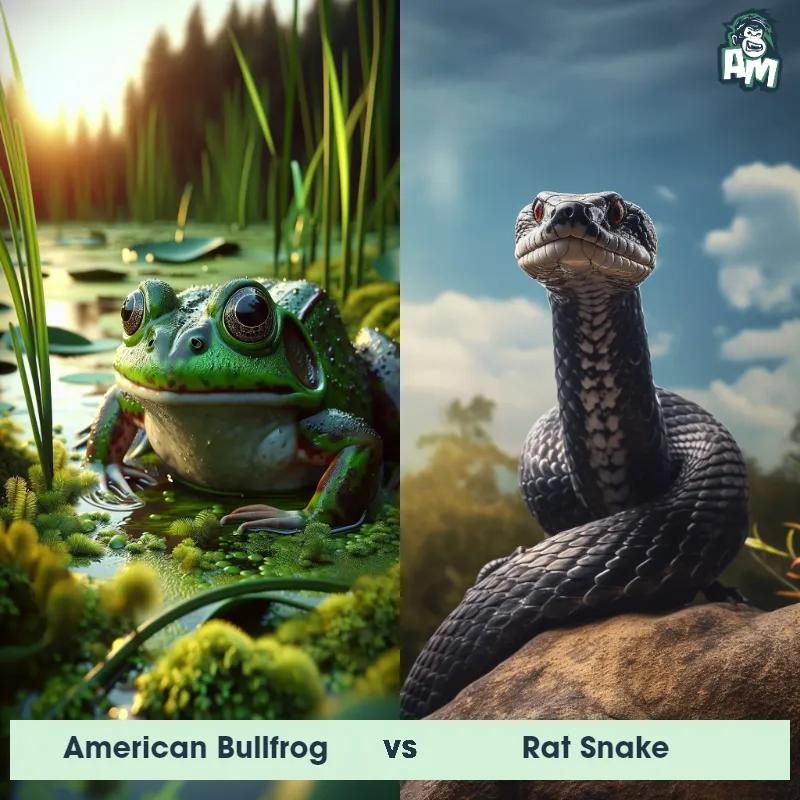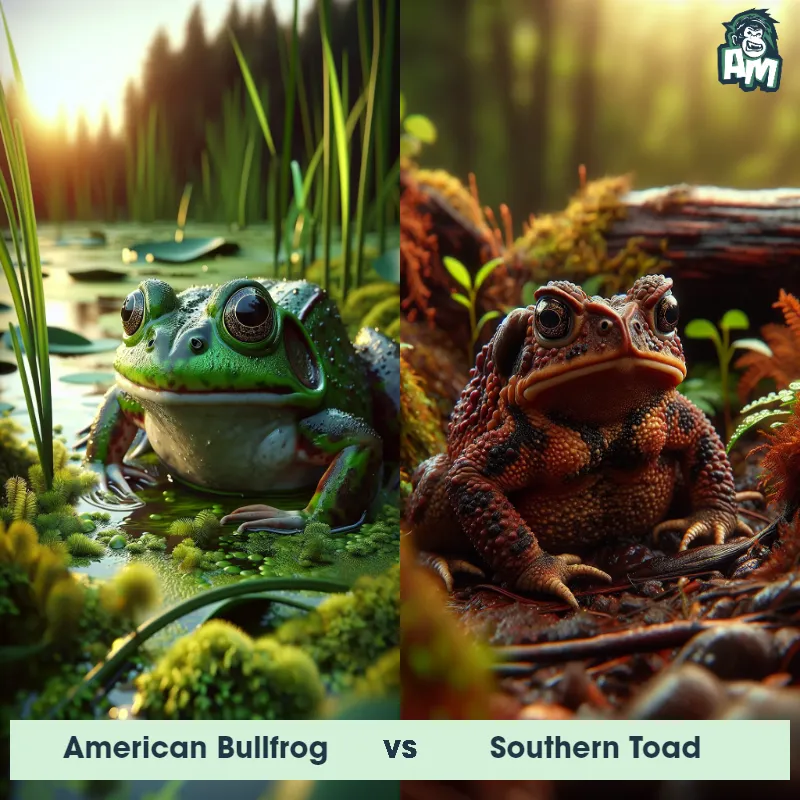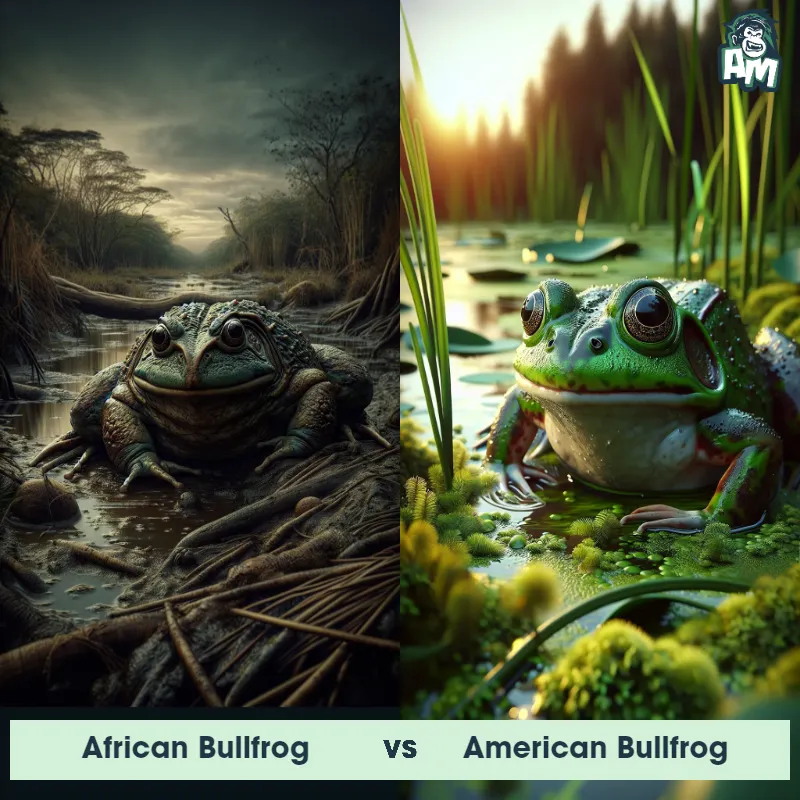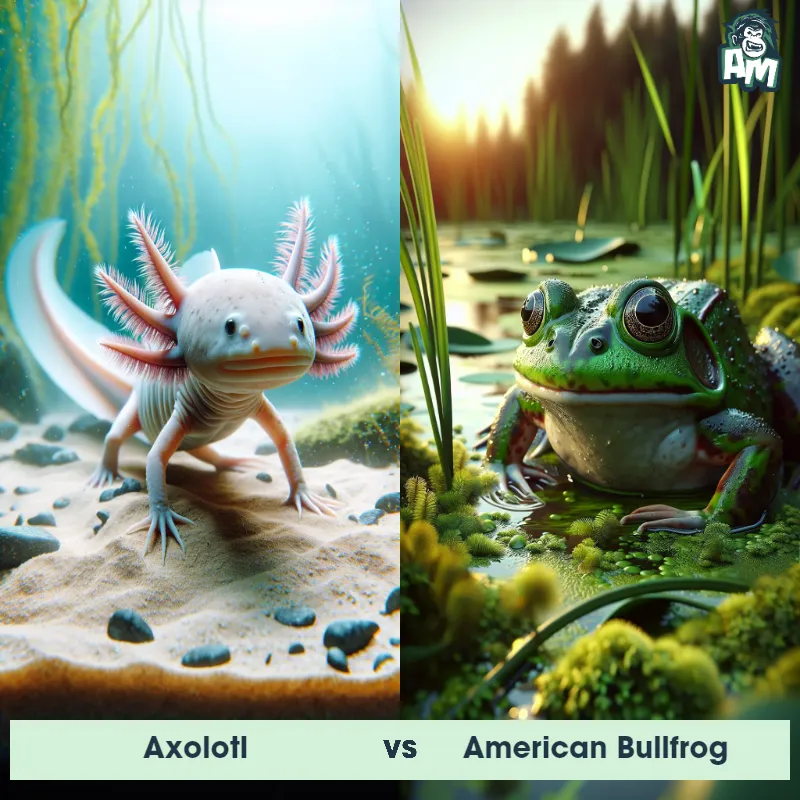The American Bullfrog
The American Bullfrog is a large species of frog known for its deep croaking call that can be heard near bodies of water. They have green or brownish skin with dark blotches and a white belly. Their hind legs are long and powerful, allowing them to jump far distances. These frogs are opportunistic feeders, consuming insects, small fish, and even other frogs.

| American Bullfrog | |
|---|---|
| Size | Up to 6 inches (15 cm) in body length |
| Weight | Up to 1.1 pounds (500 grams) |
| Speed | 3 mph (4.8 km/h) |
| Key Strength | Powerful hind legs for jumping |
| Biggest Weakness | Vulnerable belly |
| Scientific Name | Lithobates catesbeianus |
| Family | Ranidae |
| Habitat | Aquatic and terrestrial environments |
| Geography | North America |
| Diet | Insects, small mammals, fish, frogs |
| Lifespan | 7 years - 9 years |

The American Bullfrog
The American Bullfrog is a large species of frog known for its deep croaking call that can be heard near bodies of water. They have green or brownish skin with dark blotches and a white belly. Their hind legs are long and powerful, allowing them to jump far distances. These frogs are opportunistic feeders, consuming insects, small fish, and even other frogs.
Fun Fact: The American Bullfrog is one of the largest frog species in North America, with females reaching lengths of up to 8 inches.
| American Bullfrog | |
|---|---|
| Size | Up to 6 inches (15 cm) in body length |
| Weight | Up to 1.1 pounds (500 grams) |
| Speed | 3 mph (4.8 km/h) |
| Key Strength | Powerful hind legs for jumping |
| Biggest Weakness | Vulnerable belly |
| Scientific Name | Lithobates catesbeianus |
| Family | Ranidae |
| Habitat | Aquatic and terrestrial environments |
| Geography | North America |
| Diet | Insects, small mammals, fish, frogs |
| Lifespan | 7 years - 9 years |
American Bullfrog Matchups
We use AI to simulate matchups between the American Bullfrog and other animals. Our simulation considers size, strength, and natural predatory behaviors to determine the most likely outcome.

Can't find the Matchup you want?
Create Your Own MatchupAmerican Bullfrog: Diet, Predators, Aggression, and Defensive Behaviors
What do American Bullfrogs eat?
American Bullfrogs are opportunistic carnivores, feeding on a wide variety of prey. Their diet mainly consists of insects, small mammals, fish, birds, and even other amphibians. They are known to be voracious predators and have a strong appetite for anything that can fit in their mouths.
Do American Bullfrogs have any predators?
Despite their size and aggressive nature, American Bullfrogs do have predators in their natural habitat. Some of their predators include birds of prey, snakes, raccoons, and larger frogs. They are especially vulnerable as tadpoles and young frogs when they are still relatively small and easy targets.
Are American Bullfrogs aggressive?
American Bullfrogs are known to be aggressive predators, especially when it comes to defending their territory or securing prey. They will often exhibit territorial behavior towards other frogs, including chasing and fighting to establish dominance in their environment. However, they are not typically aggressive towards humans unless provoked.
Do American Bullfrogs fight?
American Bullfrogs do engage in physical fights with other frogs, especially during the breeding season when competition for mates and territories is high. These fights can involve aggressive behaviors such as pushing, shoving, and vocalizations to establish dominance. The winner of these fights will typically have access to better resources and breeding opportunities.
How do American Bullfrogs defend themselves?
American Bullfrogs have several defense mechanisms to protect themselves from predators or threats. When threatened, they will puff themselves up to appear larger, emit loud distress calls to attract attention, and use their powerful hind legs to jump away quickly. They may also release a toxic substance from their skin as a last resort to deter predators.
What is the biggest weakness of American Bullfrogs in a fight?
Despite their size and strength, American Bullfrogs have a vulnerable spot that can be exploited in a fight - their relatively soft underbelly. Due to their anatomy and the need for flexibility in jumping and swimming, their underside is not as well protected as their back and limbs. Predators and rival frogs may target this area to gain an advantage in a physical confrontation.
Fun Fact: American Bullfrogs have a unique way of breathing, as they can inflate their lungs and absorb oxygen through their skin, allowing them to stay submerged for long periods.
Fun Fact: In addition to their distinctive call, male American Bullfrogs have vocal sacs that help amplify their mating calls to attract females from a distance.



